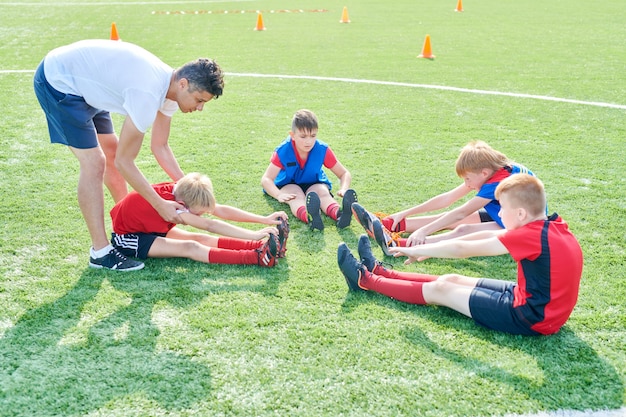Why Youth Football Programs Matter
Anúncios
Youth football programs play a pivotal role in shaping not only athletic skills but also the overall well-being of participants. One of the most significant benefits is the improvement in physical fitness. Regular participation in these programs encourages children to engage in physical activity, combating issues such as obesity and promoting cardiovascular health. Through structured drills and exercises, young athletes develop strength, agility, and endurance, laying a foundation for a healthy lifestyle.
Additionally, youth football programs foster essential teamwork skills. Players learn the importance of collaboration, communication, and mutual support, which are vital not only on the field but in every aspect of life. They gain an understanding of working towards a common goal, celebrating collective success while learning to handle losses gracefully.
Anúncios
Furthermore, these programs impart critical life skills that extend beyond football. Participants cultivate discipline, time management, and perseverance through practice and competition. Balancing sports with academics teaches responsibility, while overcoming challenges builds resilience. Such attributes are invaluable as children transition into adulthood, equipping them to navigate future endeavors with confidence and tenacity.
Key Fundamentals of Youth Football Drills
For instance, dribbling drills encourage players to improve their ball control and agility, enabling them to navigate through opponents effectively. Passing drills, on the other hand, promote teamwork and communication on the field, ensuring that players develop strategic plays together. Furthermore, shooting drills help refine players’ accuracy and power, critical for converting chances into goals. Through consistent practice, these drills solidify foundational skills, preparing young athletes for more advanced techniques in the future.
Effective Drills for Beginners

Anúncios
Introducing effective drills for beginners is essential in laying a strong foundation for youth football programs. Each drill is designed to enhance specific skills while keeping engagement levels high. The key is to focus on fun, teamwork, and gradual skill improvement.
One of the simplest drills is the ‘Cone Dribble.’ Set up a series of cones spaced apart. The objective is for players to navigate through the cones using controlled dribbling. This drill builds dexterity and ball control, crucial for young athletes.
Another effective drill is ‘Passing Pairs.’ Players work in pairs, standing about ten yards apart. They pass the ball back and forth, focusing on accuracy and technique. This exercise improves passing skills and promotes communication.
‘Shuttle Runs’ are also great for conditioning and speed. Mark two points about 20 yards apart. Players sprint back and forth between the markers, promoting endurance and agility. Incorporating these drills into practice sessions can greatly enhance skill development in youth football.
How to Create a Fun Practice Environment
Inspirational Quote
“Play is the highest form of research.” – Albert Einstein
This quote by Einstein resonates profoundly with the essence of youth football practices. It highlights the importance of exploring and experimenting through play, which ultimately leads to deeper understanding and mastery of skills. By embracing playfulness in training, coaches not only enhance learning but also inspire young athletes to discover their passion for the game, turning each practice into a valuable learning experience.
Measuring Progress and Setting Goals
Tracking progress in young athletes is crucial for their development and motivation. One effective method is to implement a variety of drills that not only challenge their skills but also allow for measurable outcomes. Utilizing drills that focus on specific aspects such as passing accuracy, speed, and agility can provide tangible data on improvement over time. Coaches can establish benchmarks at the beginning of the season, enabling them to compare performances at regular intervals.
Setting achievable goals is equally important. Coaches should collaborate with young athletes to establish realistic objectives tailored to their skill levels. For instance, a goal might be to improve passing completion rates by a certain percentage within a month. These specific targets make progress visible, instilling a sense of accomplishment as athletes reach their milestones.
Incorporating feedback sessions after each drill is beneficial. During these sessions, athletes can reflect on their performances, understand areas that require improvement, and stay aligned with their goals. This reflective practice not only enhances learning but also reinforces confidence and commitment to their development. Furthermore, celebrating small victories when goals are achieved can serve as powerful motivation for young players.
Frequently Asked Questions (FAQ)
- 1. How can I track the progress of young athletes effectively?
- To track progress effectively, implement a variety of drills that measure specific skills such as accuracy, speed, and agility, and establish benchmarks at the beginning of the season for comparison.
- 2. What types of drills are recommended for assessing young athletes’ skills?
- Recommended drills include passing accuracy tests, sprinting cones for speed, and agility ladder exercises. These drills provide measurable outcomes to assess improvement.
- 3. How should goals be set for young athletes?
- Goals should be tailored to individual skill levels and established collaboratively between coaches and athletes. They should be specific, achievable, and time-bound to track progress effectively.
- 4. What role do feedback sessions play in athlete development?
- Feedback sessions are crucial as they allow athletes to reflect on their performances, identify areas for improvement, and stay motivated towards their goals.
- 5. How can celebrating small victories help young athletes?
- Celebrating small victories boosts motivation and reinforces a sense of accomplishment, encouraging athletes to continue working toward their larger goals.